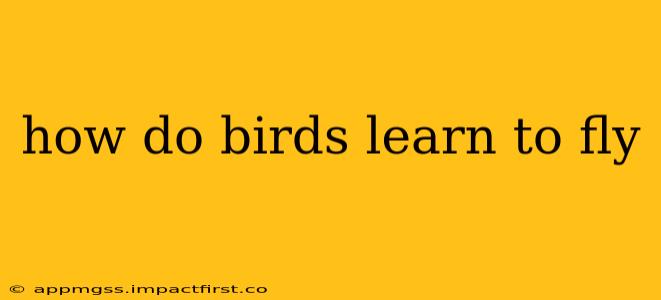Learning to fly is a crucial developmental milestone for birds, a complex process involving instinct, practice, and parental guidance. It's not a simple case of flapping wings and taking off; it's a gradual learning curve honed over millennia of evolution. This comprehensive guide delves into the intricacies of avian flight development, answering frequently asked questions and exploring the fascinating science behind this natural wonder.
What Instincts Do Birds Have That Help Them Learn to Fly?
Birds are born with a fundamental understanding of flight. This innate predisposition, or instinct, guides their early development and behaviors. For instance, fledgling birds possess an innate understanding of how to position their wings and body for balance and movement. Their nervous system is pre-wired to respond to certain stimuli, such as air currents and visual cues, enabling them to begin coordinating their movements towards flight. This innate ability forms the crucial foundation upon which learned behaviors are built. However, instinct alone isn't enough; practice and environmental factors play equally vital roles.
How Do Baby Birds Learn to Fly?
The learning process varies depending on the species of bird. Precocial birds, like ducks and chickens, are relatively independent from birth. They can walk and feed themselves almost immediately, and their flight development is more gradual. They spend time practicing flapping their wings and jumping, gradually increasing their wing strength and coordination.
Altricial birds, like robins and sparrows, are born helpless and require extensive parental care. Their flight learning is a more staged process. Initially, they focus on strengthening their wings and legs through flapping and hopping. Parents play a crucial role, providing food and protection while encouraging their young to practice their wing movements. They also demonstrate flight techniques, providing visual learning cues. As the fledglings mature, they begin making short hops and glides, gradually increasing the duration and distance of their flights.
Do Birds Need Lessons From Their Parents to Fly?
While instinct provides the basic blueprint, parental guidance is incredibly important for many bird species, particularly altricial birds. Parents often demonstrate flight behaviors, acting as visual instructors. They encourage their young to practice by feeding them while they are airborne or guiding them through flight exercises. This parental instruction isn’t a formal lesson but rather a form of observational learning and positive reinforcement. The parent's actions and vocalizations play a vital role in shaping the fledgling's flight skills.
What Are the Stages of Flight Development in Birds?
Bird flight development is typically a three-stage process:
-
Wing flapping and hopping: Early stages involve flapping wings and hopping, strengthening muscles and coordinating movements.
-
Short flights and glides: Gradually, they transition to short, controlled flights and glides, gaining confidence and improving aerial maneuvers.
-
Sustained flight: Finally, they achieve sustained flight, capable of longer flights and more complex aerial navigation.
The duration of each stage varies considerably across bird species, depending on factors like body size, wing shape, and the environmental demands of their habitat.
How Long Does it Take a Bird to Learn to Fly?
The time it takes a bird to learn to fly varies significantly depending on the species. Some precocial birds might be flying within days of hatching, while altricial birds can take several weeks or even months. Factors influencing this timeline include the bird's species, size, and environmental conditions. The presence or absence of significant parental guidance also plays a crucial role.
Do All Birds Learn to Fly?
No, not all birds learn to fly. Flightless birds, like penguins and ostriches, have evolved to lose their ability to fly, adapting to terrestrial or aquatic environments. Their wings have evolved for different purposes, such as swimming (penguins) or running (ostriches). Their skeletal structure and musculature are also adapted for these alternative forms of locomotion.
Conclusion: A Triumph of Instinct and Learning
Learning to fly is a remarkable achievement, a testament to the intricate interplay of instinct and learned behavior. While the innate capacity for flight is present from birth, the refinement of this ability is shaped by practice, environmental influences, and the crucial role of parental guidance for many species. The diversity in flight development across avian species highlights the adaptability and evolutionary brilliance of the natural world.
